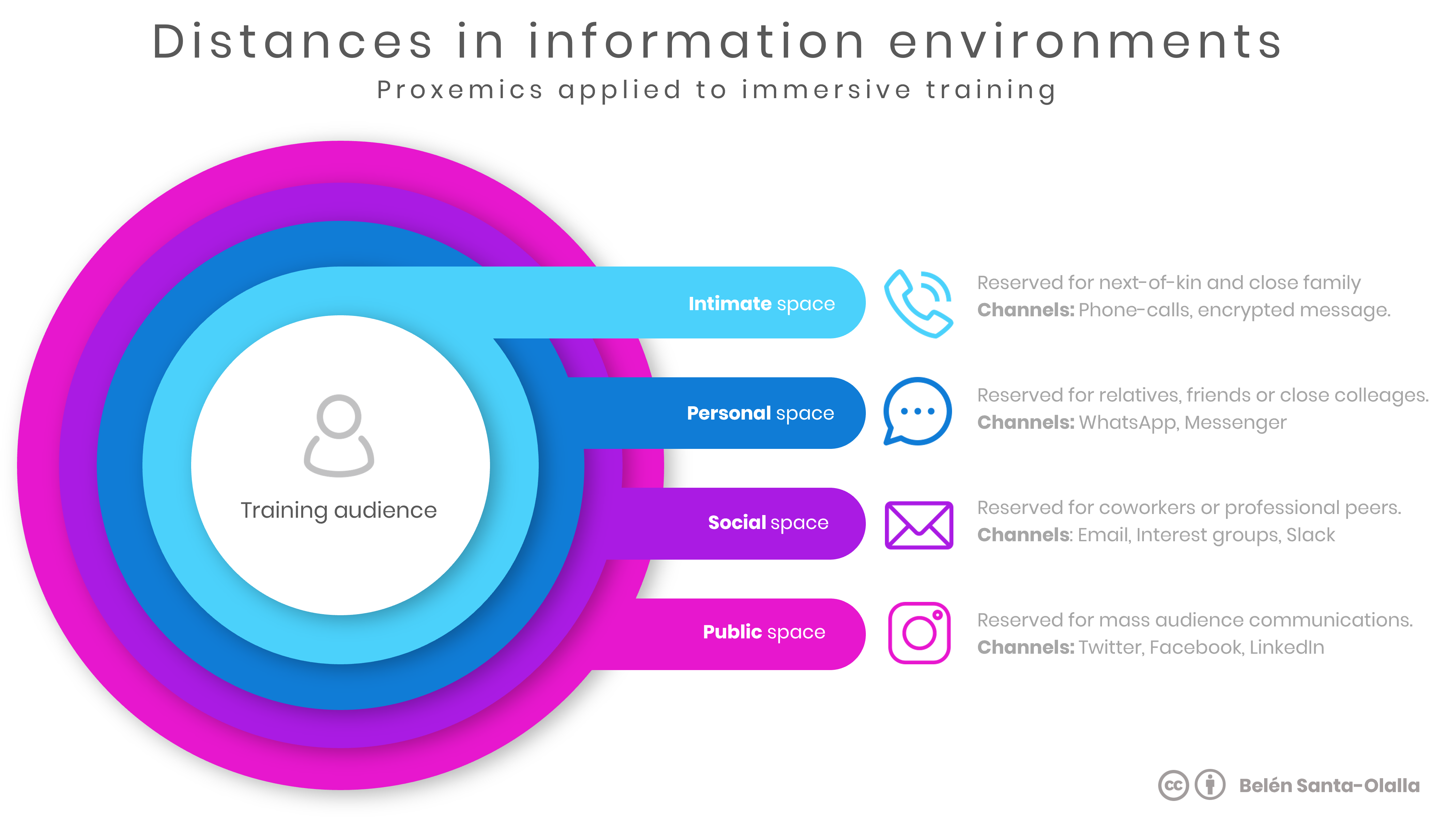As crisis designers, we make scenarios unfold by using personas, characters that deliver context and events. However, to make an exercise truly engaging, we need to think of another ‘person’, that is the Training Audience. The communication between the training audience and the scenario personas is a really important factor to generate believable events.
In a story we just witness, emotion is normally triggered through empathy with the characters. But in an exercise we actively participate in as training audience, emotion can be elicited by a smart use of distances. For this, we are going to use proxemics, a discipline of semiotics that focuses on the role played by space and distances in interpersonal communication.
Proxemics focuses on analyzing the different spaces and distances that surround our body, in which different social encounters take place. If we are creating a scenario, it’s interesting to think how these spaces would translate into an information environment:

• Public space: In a physical space it is the farthest from our body, and it is the one we use to address a group of people so that everyone can see and hear us. It is the most neutral and impersonal, and its digital counterpart would be social networks (Facebook, Twitter, Instagram…) where individuals post to an indefinite audience seeking attention.
• Social space: Where we deal with peers, colleagues or coworkers. In the digital sphere, this would be interest groups (Facebook Groups or forums), professional networks (LinkedIn) and one-on-one communications of a non-personal nature (emails).
• Personal space: Reserved for close people, friends and family, where matters are discussed in a more relaxed and personal way. Online, we would be talking about WhatsApp or Messenger, or more traditional channels such as SMS.
• Intimate space: In proxemics, this is the closest space to our body, a few centimetres from our skin. Obviously, this distance is reserved for very important people. We can replicate this in an information environment using the most direct and intimate way to reach someone: phone calls, or even encrypted messages.
According to proxemics, how we use these spaces varies according to the concessions every individual makes, which depend on:
- The person we are dealing with: the intimate distance with my brother is not the same as with my partner.
- Where we are: social distance is reduced in a lift, for example.
- What situation we are in: in a doctor’s visit, we let a stranger enter our intimate distance.
How to generate emotions using proxemics
The great power of proxemics is that it operates on each of us at unconscious levels. It has a cultural component (i.e. Spaniards accept shorter distances for a social space than Britons), but it is one of our animal vestiges of territoriality. So if there is something out of order in our understanding of distances, we try to re-establish them to return to our comfort zone.
That is why they are a valuable tool that we can use to generate immediate reactions in our training audience. Here’s a bunch of ideas:
1. Transit through the different distances: in an unfolding scenario, it can be interesting to use:
- a. Approaching: a persona makes herself known to the training audience in a public space (on a public network or in a speech) and then approaches through all the four spaces until they reach the intimate space (i.e. makes a phone call). Apart from giving depth to the personas, it generates bonds of trust and empathy.
- b. Distancing: Encounters and disclosures that occur in intimate space can be revealed and amplified in public space, leading to feelings of vulnerability and exposure.
- c. Jumping: any unexpected movement between spaces generates strangeness or even fear. For example, a persona that is introduced at a social distance is discovered to be spying on our intimate space (i.e. a hacker in a ransomware scenario)
2. Violate tacit rules of these spaces: when the scenario events don’t follow the inherent rules of each space, this generates immediate interest in the training audience, as they wonder about the reason for this violation. For example, a persona confesses something really intimate during a breaking news video.
3. Include a time component: There are certain distances that, if violated at certain times, generate an even greater impact. For example, an email or phone call received at 11am has a different meaning if received at 3am.
These are just a few ideas that we find appealing for crisis designers. As McLuhan said, the medium is the message, and the choice of distances and choice of channels becomes part of the non-verbal communication of our personas. What your personas say is important, but also where they say it from.



 Training Cyber Terrorism Professionals
Training Cyber Terrorism Professionals